Little Benges (Cider Mill Farm)

The property known as Little Benges can be found at Priors Norton on the lane leading away from the church at the back of the hill. Over the years the boundaries between Little Benges, Benges Farm, and other properties in this area are very blurred and, as a result, there will be a duplication in this account and others.
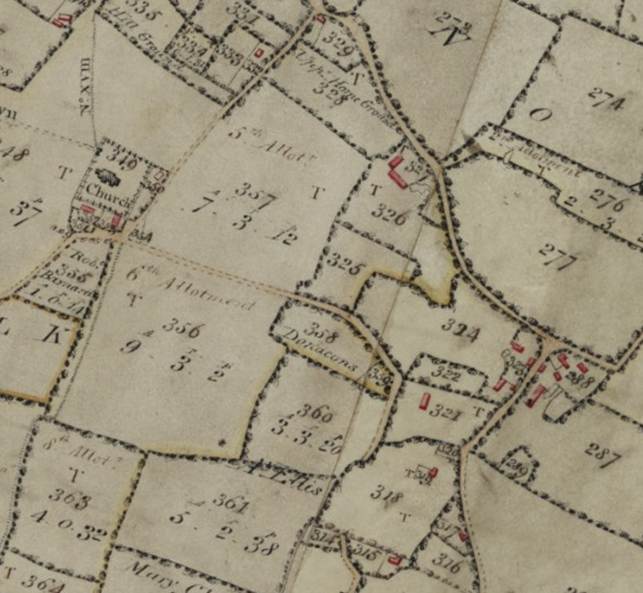
[1807]
When the Inclosures came to Norton in 1807 the above plan was produced and this shows the properties that could be found in this part of Priors Norton at that time. There was a track running from opposite the church straight down the back of the hill to what is now Benges Farm, Plot No 321, the site of what is now Little Benges would have been Plot No 323, opposite Ivy House Farm at Plot No 288, and it was then owned by Anthony Ellis, was a homestead of 2 roods, 31 perches in area.
Anthony was baptised on 15 July 1759 at St Nicholas, Gloucester, son of Robert and Alice Ellis. Anthony was also a first cousin of James ‘Jemmy’ Wood, who was an interesting, and very wealthy, character who owned a bank in Gloucester as well as property in local villages. The Ellis family were ironmongers, had occupied a property at 68 Westgate Street, Gloucester, since the early eighteenth century, and had acquired an additional property at the rear of their shop in 1809. Part of this additional property, ‘the great whitening house’, was incorporated with 70 Westgate Street by 1843, and was subsequently used as a back kitchen.
In 1809 Anthony Ellis gave a benefaction of 15 acres at Norton to St Nicholas’ of Gloucester, with the trustees to pay any income to the incumbent of St Nicholas in return for him preaching a morning ‘lecture’ every Sunday at St Nicholas church. In 1807, Anthony Ellis owned the following plots, all in the area of what is now Benges.
308 – Mouchers Corner & Ten lands 5- 0-34
309 – Dowdeswells Piece 2- 0-30
310 – Part of Long Leazow 0- 2-20
311 – Allotment in Lower Church Field 8- 0-18
316 – Kings Close 0- 3-36
322 – Orchard 0- 2-22
323 – Homestead 0- 2-31
324 – Home Ground 2- 3-37
360 – Part of Great Donnacans 3- 3-20
361 – Allotment in Upper Church Field 5- 2-38
383 – Woodcroft Hedge Piece 4- 0-22
Anthony Ellis died in 1826 but his benefaction appears to have still been extant in 1828 when there is a terrier of lands, including the 15 acres at Norton, that belonged to the benefice of St Nicholas, Gloucester. There appear to have been five benefaction sermons and the incumbents had the right to half-yearly collections from the parishioners at Norton.
On 25 June 1828 at the Kings Head Inn, Gloucester, Thomas Cooke was authorised to sell, by auction, the Manor of Priors Norton along with Norton Court Farm, the water corn and grist mill, and several other properties at Benges. The auction leaflet included the following plan which is slightly confusing in that north is at the bottom and south at the top.
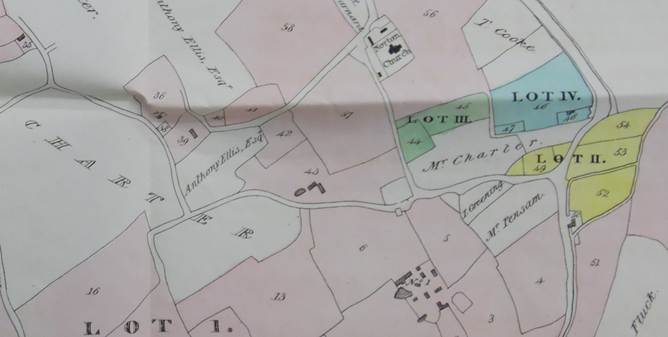
Anthony Ellis had died in 1826 but what is now Little Benges is still marked on the 1828 plan as belonging to Anthony Ellis Esq and didn’t form part of this sale.
An article in the Gloucestershire Chronicle newspaper of 23 Sep 1882 tells us more about Anthony; “a very eccentric character lived in Westgate-street, in a house opposite the Shire Hall. His name was Anthony Ellis, and he kept an ironmonger’s shop. He was very rich, and had large landed possessions in the county. He was first cousin to James Wood, and it was said that he was partner with him in the Old Bank. They mutually took a very great interest in the stability and reputation of the bank, and to consolidate the strength of its foundation they agreed that their wealth should never be disintegrated or divided; and for this purpose they entered into a solemn compact that whoever died first should leave his property to the survivor. Anthony Ellis, who was said to be a great miser, entertained the flattering hope that he should live longer than his cousin, and that he should possess his property. Alas ! Death prepared his dart for Anthony before he thought of James. Mr Wood inherited the whole of his cousin’s immense property. … As soon as James Wood heard that his cousin was dead he followed the messenger down to the shop and ordered the shutters to be put up and the door to be closed. … Anthony, like many other misers, had hidden gold in the most inconceivable places. Jemmy appeared to have been familiar with all his secret holes and corners, for as soon as the shutters had been put up he commenced the most assiduous and vigilant search for hidden treasure. When I was a boy, a man told me that he was employed to remove some things from Anthony Ellis’ house after his death. He said there were several wells in the cellar in which were deposited old coppers. They were corroded with verdigris, and he had to get them out with a pickaxe and shovel. According to his estimate there must have been more than a ton of old coppers”.
Anthony died in 1826 and, in his Will, he did largely leave his estate to Jemmy Wood.
The Citizen newspaper, nearly 100 years after Jemmy’s death, published in April 1936, tells us a story of his time at the farm in Norton; “Jemmy Wood owned a farm at Norton, where he was in the habit of sojourning occasionally for lengthy week-ends to enjoy a few days shooting. One particular day, equipped with a brace of pheasants and a bottle of rare port wine, Jemmy went to the farm house at Norton and summoned to him the boy who did the odd jobs about the house and farm. The banker instructed the youth to roast the two birds in front of the open fire, and placing the bottle of wine on the table he told him that it contained very virulent poison, the slightest drop of which would reap its toll. The boy began to roast the pheasants, but the delicate odour wafting towards him during the operation proved too much, and his hand was soon travelling to his mouth, and each time it contained a portion of one of the birds. Soon the lad found that the choicest sections of both pheasants had disappeared, and greatly alarmed at what he imagined would be his fate, he decided to commit suicide. Walking towards the table he picked up the bottle of what he thought was poison and quaffed it off. His employer found him lying in the grate, not dead, but dead drunk. The outcome can best be imagined”.
In 1838 Anthony’s benefaction can be identified as the land is recorded in the occupation of “the Minister for the time being of the parish of St Nicholas, Gloucester” and was described as being Ellis’ Gift. It was then 16 acres and 22 perches and was occupied by Henry Green who was at Norton Mill at this time. The land had a gross estimated rental or annual value of £20 and a rateable value or net annual value of £17. The land in question was recorded as follows;
308 Mouchers Corner and Ten Lands, 5-0-34
309 Dowdeswells Piece, 2-0-30
310 Part of Long Leazow, 0-2-20
311 Allotment in Lower Church Field, 8-0-18
In 1838, what is now Little Benges was described as being a cider mill, house, buildings and garden, and was owned by Sir Matthew Wood’s bank.
Jemmy Wood died in 1836 and was buried at St Mary de Crypt, Gloucester, where there is still a memorial to him in the chancel. Jemmy wasn’t a popular man and it is said that his coffin was stoned as it was being carried to the church.
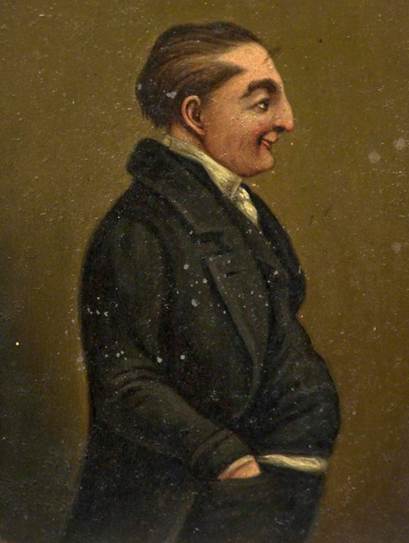
James ‘Jemmy’ Wood
Jemmy left his estates to the executors of his will; Sir Matthew Wood, John Chadborn (Solicitor), Jacob Osborne and John S. Surman but later a codicil was discovered that left monies to the City of Gloucester amongst others and a protracted dispute then followed that swallowed up much of the value of his estate.
On 22 June 1843 a deed of partition was written that included the following description of James Wood’s Norton estate; “All that messuage or tenement and farm all those several closes pieces or parcels of arable land meadow or pasture ground thereunto belonging or situate and being in the parish of Norton in the county of Gloucester being freehold of inheritance now in the tenure of Thomas Marston containing together fourteen acres two roods and thirty nine perches and known by the several names and containing the respective quantities hereinafter mentioned that is to say the house and garden with the yards ad outbuildings thereto belonging containing two roods thirty nine perches, the Home Ground pasture containing one acre two roods eighteen perches, the Little Orchard pasture and orcharding containing two roods twenty seven perches, the Orchard pasture and orcharding containing one acre two roods seven perches, a close of arable land called Donakins containing three acres two roods twenty two perches, a close called Poppy Hill being ley containing five acres two roods thirty four perches, and a piece of pasture called Kings Croft otherwise Kings Close containing three roods six perches.
All of which messuage or tenement farm and lands were heretofore known by the description following that is to say, all that messuage or dwelling house with the brewhouse barn stable outhouses and garden heretofore adjoining and also all tat orchard adjoining the said garden containing by estimate three quarters of an acres And also all that piece or parcel of pasture ground adjoining to the said orchard containing by estimate three acres and a half and Also all that piece or parcel of pasture ground known or called by the name of Kings Croft containing by estimation one acre And all that piece or parcel of land being No 360 on the award made under an Act for inclosing lands in the said parish of Norton being the south part of an old inclosure called Great Donakins containing three acres three roods twenty perches including the road over the same Also all that piece or parcel of land in the Upper Church Field, No 361, containing five acres two roods thirty eight perches which two last described allotments adjoin together and are bounded in part of the east by an old inclosure belonging to James Bird another part of the east and on the south by an allotment awarded to Mary Charter and on all other parts by old inclosures and allotments made to the Duke of Norfolk”.
In 1851 Samuel Roberts was farming 16 acres at a property recorded as Benges Farm but with the acreage this could have been what was Anthony Ellis’property and what became Little Benges. Samuel was born in 1807 at Birmingham, son of Samuel and Esther Roberts. In 1841 Samuel jnr was living with his parents near The Green at Norton with his father employed as a brushmaker and Samuel jnr as a shoemaker. In 1851 Samuel was still single when he first came to Benges and recorded himself as a farmer. Samuel married Sarah Hughes of Norton at St Mary’s, in October 1851 when he declared himself to be a labourer. In 1861 Samuel, an agricultural labourer, and Sarah were still living at Worlds End with three young children, possibly in a property next door to Benges Farm, so maybe still at Little Benges. Samuel and Sarah were still in the village in 1871 and 1881, and had a total of five children, but do not appear to have been living at Priors Norton. Samuel died in October 1886 and was buried at St Mary’s. Widowed Sarah remained at Norton, living alone and working as a washerwoman. Sarah was still at Norton in 1901 but was at Gloucester when she died in December 1907 and was also buried at St Mary’s.
In 1861 the widowed Elizabeth Clarke was a farmer at Cider Mill Farm of 15 acres in the area of Benges and Ivy House and likely this property. Elizabeth was living here with children William and Mary, both born at Skenfrith, Monmouth, and her widowed father William. Elizabeth was born at Redmarley and baptised at Dymock in 1814, daughter of William and Elizabeth Clarke, farmers. No marriage can be identified, and her father was also a Clarke, so possibly her children were illegitimate. Elizabeth had arrived at Norton by 1861 and remained in the village until her death in September 1905 when she was buried at St Mary’s, Norton. It is only in 1861 that she is at the named Cider Mill Farm although she remained at Priors Norton in a cottage ‘by the church’ until her death in September 1905. This must have been Church Cottage. In 1891 she was recorded as being a midwife and being sick at that time. She was buried at St Mary’s.
The earliest I have found mention of Little Benges by this name is in the Gloucester Journal newspaper of 8 December 1900 when they reported on the sale of timber; “Bruton, Knowles and Co are instructed to sell by auction, at the New Inn Hotel, Gloucester, on Wednesday, December 12th, 1900, at 1 for 2 o’clock, in two lots, - 49 elm and other timber trees, standing on Benges Farm, Norton, in the occupation of Mr S Chandler, and Little Benges Farm, in the occupation of Mr John Webb”.

Gloucestershire Chronicle, 8 December 1900
John was born at Elmore in 1857, son of George, a labourer and sailor, and Ann Webb and was living at Sherborne Street, Gloucester, employed as a fisherman, when he married Letitia Niblett on 17 January 1881 at St Marks, Kingsholm, Gloucester. Letitia was born at Town Street, Tirley on 17 January 1854, daughter of William, a labourer and hay trusser, and Rachel Niblett and she too was living at Sherborne Street when they married. After marriage John and Letitia settled with John’s widowed mother at Elmore where John worked as a fisherman. By 1891 they had crossed the river and were living at Minsterworth with five children. In 1901 John, Letitia Webb and their four children had arrived at Norton and were living at Little Benges. The Webbs were still here in 1906 but in 1911 the family were living at 2 Prospect Villa, Armscroft, Barnwood, where John was farming. In 1918 the Webbs were living at High Ley, Minsterworth, where John was a farmer and son William was assisting his father and was also a fisherman. John died in January 1939 and widowed Letitia continued to live alone at Prestbury Farm, Churcham, and she was still here when she died in October 1950. Both John and Letitia were buried at Minsterworth.
From approximately 1910 Rev Henry Wilkinson Pearson, owned ‘freehold land and buildings’ at Little Benges Farm but lived at Freshwater, Isle of Wight. Henry was born at Lambley, Notts, in 1884, son of Rev Henry and Mary Isabella Pearson, and grew up there. By 1901 the family were living at Hampstead, London. Henry followed his father into the church and by 1916 had returned to Lambley, Notts, where he was the parish incumbent. He died at Sherringham, Norfolk, in 1972.
In 1911 Henry, often known as Alfred, Bevan was living with his wife Elizabeth and 5 young children in a 5 roomed property at Worlds End, Norton, employed as a carter on a farm, and this would have been at Little Benges. Henry Alfred Bevan was born at Churcham in 1877, son of Albert and Mary Bevan, and married Elizabeth Alice, the daughter of James Hyett and Amelia (nee Wilkins), at Taynton in November 1900. It appears that the Bevans arrived at Norton in 1908, presumably taking over when the Webbs left, and their common ground of Churcham meant it was likely that they all knew each other. In 1911 Elizabeth’s parents, James and Amelia Hyett were living at The Lodge, Norton Court Farm. In 1915 the Bevan’s daughter Efruzyne died, aged just 14 years, and her death certificate confirms that they were living at Little Benges then. The Bevans were still living in a 6 roomed property at Little Benges, with seven children, in 1921 when Alfred was employed as a carter working for Mr Archer of Norton Court Farm.
In the 1990s I met Catherine Riddick (nee Groves) who grew up at Ivy House Farm 1916-1924 and amongst the memories she shared was; “There was a black and white house before you got to Ivy House and a large family called Bevan lived there. He worked for Mr Archer at Norton Court Farm”. This fits a later description I have for Little Benges.
The Gloucestershire Chronicle newspaper of 20 March 1920 reported an auction; “Bruton, Knowles and Co will sell by auction at the Bell Hotel, Gloucester, on Monday, March 22nd, 1920, at 3 o’clock punctually, the following freehold properties, - By direction of the Rev H Wilkinson Pearson: Little Benges Farm, situate at Norton, close to the main road from Gloucester to Tewkesbury, and comprising a Farmhouse, farm buildings, and 15a 0r 14p of superior pasture land and orcharding let to Mrs Archer for many years past on a yearly Michaelmas tenancy (and not a Lady Day tenancy as announced in previous advertisements), at the low rent of £35 a year, and offering special attractions to a butcher or dealer. Solicitors: Messrs Watson, Crewdson and Wadsworth, 15 Weekday Cross, Nottingham”. So, in 1920, Little Benges Farm still totalled 15 acres and at the auction, the property was sold to Mrs Rudge, of Norton, for £1050, with an additional £57 paid for the growing timber. The Rudge’s were resident at Benges Farm at this time.
By 1925 James and Alice Freeman were at Little Benges Farm with their family and James died here in 1927.
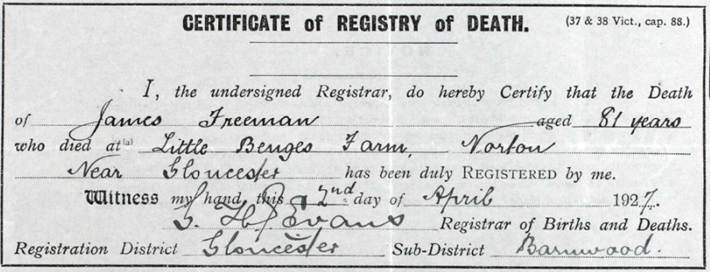
Widowed Alice lived here for the remainder of her life with her sons working the land on the neighbouring farms. The Gloucester Citizen newspaper of 15 September 1928 reported; “Two Norton dog owners, Leonard Bird, of Church Cottage, Norton, and S W Freeman, of Little Benges Farm, Norton, were each fined 7s 6d for keeping a dog without a licence on August 25th”. In 1939 Alice Freeman was still here but was recorded as being an invalid, and her daughter Lily, who had married Alfred, son of the Hyetts who lived at The Lodge, Norton Court Farm, had returned to take care of her. The Gloucester Journal newspaper of 22 June 1940 reported Alice’s death; “June 13, Little Benges, Norton, Alice Freeman, aged 90”. In 1954 only son Sidney William Freeman was still registered here moving shortly afterwards to live in a caravan on the empty site of what is now [2025] Woodside bungalow.
In 1955 Richard Eric and Margaret Kathleen Beale bought Little Benges at the same time that they bought Benges Farm, next door. Sally Beale of Benges Farm told me in July 2025; “Next door [Little Benges] came with this place, and Margaret reared turkeys in it one Christmas, and then they thought it’s more trouble than it’s worth, so one day she and her father in law, grandpa Beale, were in there smashing all the windows and pa, father in law, was busy setting chains around the posts, because it was just a timber building, just to tow it off then it would all collapse, and they could have maybe a kitchen garden or something there. Then a swanky chap in a Rolls Royce of all things pitched up and said stop I’ll buy it, and he did. So he bought it and he must have sold it eventually to the Stapletons”.
The owner of the Rolls Royce has not been positively identified but by 1966 Arthur and Clare Stapleton were at Little Benges and the property may briefly have been known as Tudor Cottage due to it’s ‘black and white’ appearance. Arthur was born at Frampton on Severn on 26 May 1913, son of Daniel Stapleton, an insurance agent and later a labourer at the Cadbury chocolate factory, and Edith Margaret nee Poole. Arthur followed his father taking employment at the Cadbury chocolate factory at Frampton for whom he also played cricket in the 1930s. Arthur married Clare Rosalie Maud Peyton on 14 December 1938 at Hardwicke, Gloucester, and they had one child; John. Clare was born at Four Mile Elm, Hardwicke, on 25 January 1912, daughter of Nathaniel John Peyton, a carpenter and wheelwright, and Jane nee Sims. After marriage Arthur and Clare lived at Highways, Claypits, Eastington, with Arthur continuing to be employed as milk chocolate worker, presumably at the Frampton chocolate factory. In 1963 Arthur was still playing cricket, then for Tewkesbury 2nd XI. Arthur died in 1988 and Clare in 2003.
In 1985 John Timothy ‘Tim’ Shaw was in residence. John was born in 1929 and married Anne Hawthornthwaite at Boddington on 25 September 1985. Anne was born in 1929 at Dewsbury, Yorks, daughter of Richard Hawthornthwaite and Sarah nee Longworth. Tim and Anne were still here in September 1997 when they were extending the property to provide extra living accommodation. The Shaws sold in 2011 moving into sheltered accommodation. Tim died on 22 December 2013 at St Oswald’s Village, Gloucester, and Anne on 28 February 2019.
Sally Beale of Benges Farm told me in July 2025; “Even the original people that I knew, Tim Shaw, wouldn’t recognise it now. I remember it as a sort of timber building. Tim Shaw was the owner, and then late in life he married Anne Hawthornthwaite, from Yorkshire. Tim tried with all sorts of scientific stuff that really didn’t work. In 2011, Anne and Tim moved off into sheltered accommodation where the old market was in St Oswalds Way. I think they had a flat each as he had so many books. Tim was a lovely man but it was a real shock when he married. The Shaws then sold to the Taylors in 2011, who really did an awful lot to it, then retired about 5 years ago to live in the Bahamas”.
The sale booklet from Farr & Farr estate agents when it was sold to the Taylors in 2011 described the property as “An attractive period house dating back to the early 17th century with close to 1/3 acre garden. 4 good bedrooms; bathroom; large sitting room with inglenook fireplace; modern dining/family room’ study; kitchen/breakfast room; cloakroom; good rear hall; oil & solar central heating; predominantly double glazed; detached double garage with studio above; ample parking; mature garden with variety of rare trees”. It was valued at £350.000.
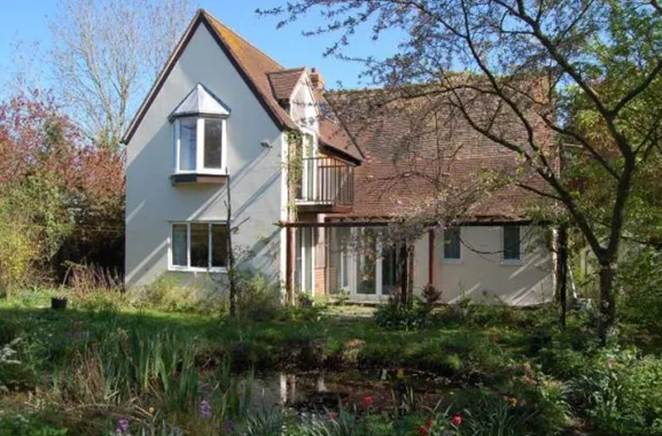
Little Benges [2011]
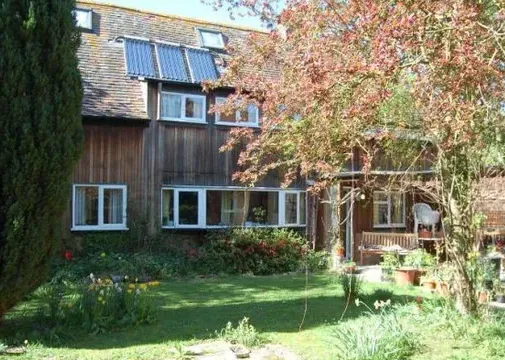
Little Benges [2011]
